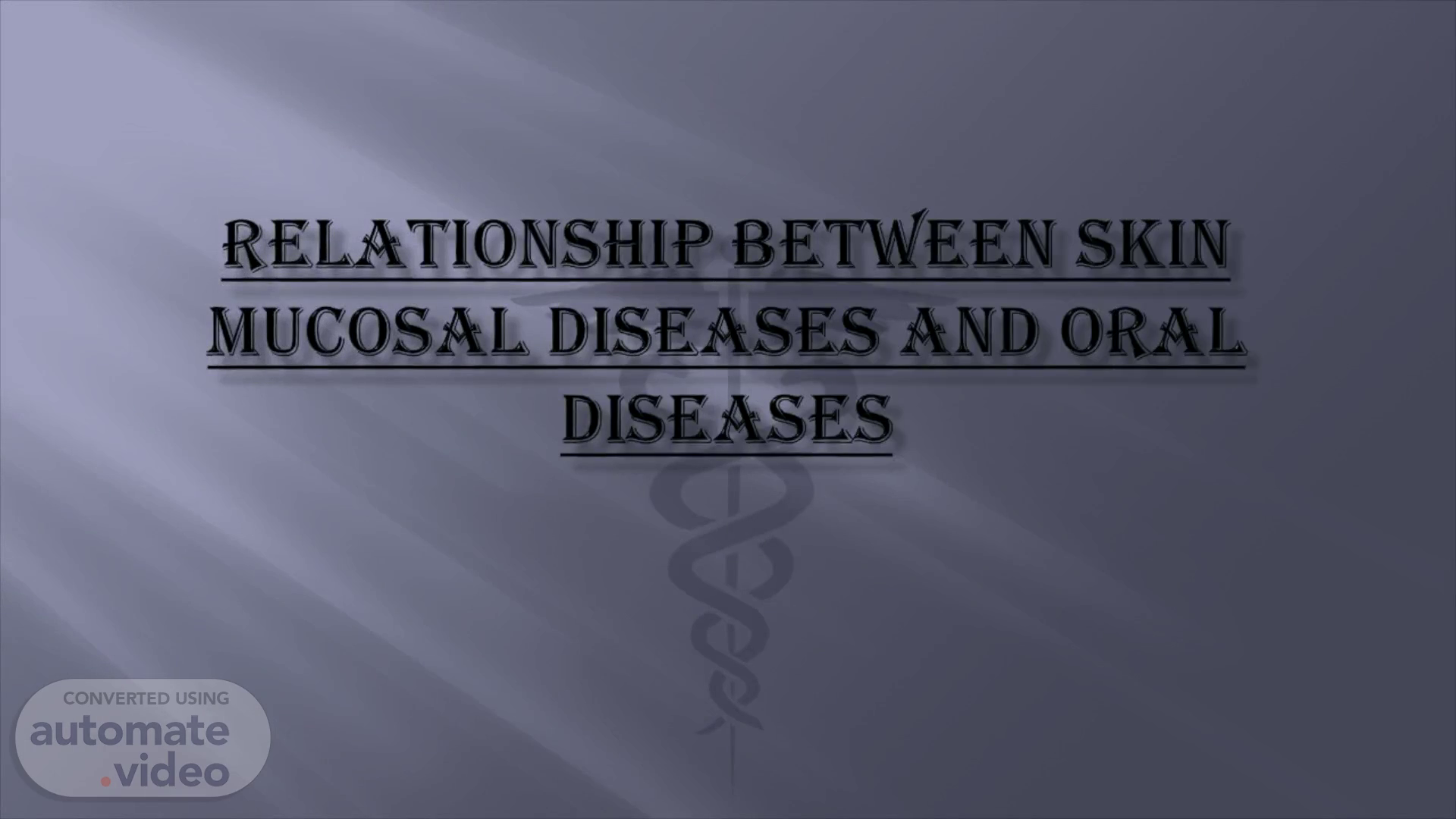
Relationship between skin mucosal diseases and oral diseases
Scene 1 (0s)
Relationship between skin mucosal diseases and oral diseases.
Scene 3 (13s)
931018201 : Divyanshi [ 戴妍诗 ] 931018212 : Chetan [ 阿凯 ] 931018214 : Nayan [ 那言 ] 931018218 : Harsh [ 哈什 ] 931018220 : Swara [ 甜甜 ] 931018223 : Vivek [ 王凌波 ] 931018228 : Sachin [ 胜利 ] 931018229 : Pranita [ 赵蕾 ] 931018230 : Aniket [ 安尼克 ] 931018234 : Prajakta [ 林品如 ] 931018243 : P ooja [ 朴佳 ] 931018244 : Arnav [ 奥纳伟 ] 931018250 : Simran [ 习米兰 ] 931018251 : Ankita [ 安基塔 ] 931018261 : Kushalta [ 柯霞塔 ] 931018265 : Haresh [ 哈林 ].
Scene 4 (38s)
SKIN MUCOSAL DISEASES Skin Mucosal disorders are diseases of the mucous membranes of the mouth and genitals caused by yeast, viruses and bacteria..
Scene 5 (59s)
OBJECTIVE The aim of our presentation is to provide an overview of common oral mucosal diseases to help with formulating a differential diagnosis and stratifying the urgency of referral ..
Scene 6 (1m 11s)
What causes oral mucosal disease? Oral mucosal diseases may have an autoimmune link, meaning the body’s immune system attacks healthy cells. Some mucosal diseases are inherited..
Scene 7 (1m 22s)
Our mucosal disease partners : Mucosal diseases can affect different parts of the body. Gastroenterology (digestive problems) Gynaecology (women’s health) Ophthalmology (vision) Otolaryngology (ear, nose, mouth and throat disorders) Rheumatology (arthritis).
Scene 8 (1m 35s)
Oral candidiasis: Oral candidiasis is an opportunistic fungal infection usually caused by Candida albicans Symptoms White patches on the inner cheeks, tongue, roof of the mouth, and throat (photo showing candidiasis in the mouth) Redness or soreness Cotton-like feeling in the mouth Loss of taste Pain while eating or swallowing Cracking and redness at the corners of the mouth. Esophagus usually include pain when swallowing and difficulty swallowing..
Scene 9 (1m 57s)
TREATMENT : The treatment for mild to moderate infections in the mouth or throat is usually an antifungal medicine applied to the inside of the mouth for 7 to 14 days. These medications include clotrimazole, miconazole, or nystatin. Fluconazole was found to be the drug of choice as a systemic treatment of oral candidiasis. Due to its good antifungal properties, its high acceptance of the patient and its efficacy compared with other antifungal drugs..
Scene 10 (2m 19s)
White, red and mixed lesions: Changes in thickness, texture and color of the oral mucosa can present an array of white and/or red lesions. Causes of these include variations of normal, frictional causes, infectious causes, immune-mediated causes and pre-malignant and malignant changes. TREATMENT Current treatments include elimination of risk behaviors, such as smoking; treatment of inflammation; medical therapies and/or excision. Close follow-up is mandatory..
Scene 11 (2m 41s)
Burning mouth syndrome This condition causes a painful burning, scalding or tingling sensation in the mouth. Symptoms most often affect the tongue and lips. Burning mouth syndrome is more common in older women..
Scene 12 (2m 55s)
TREATMENT Oral and topical pain relievers Vitamin supplements Saliva substitutes and stimulants Medications such as benzodiazepines, tricyclic antidepressants and gabapentin.
Scene 13 (3m 13s)
herpes labialis Infection with the herpes simplex virus around the border of the lips. The infection is usually caused by herpes simplex virus type 1 (HSV-1) Symptoms Mouth: sore lip, tingling, tingling lips, or ulcers Skin: blister, rashes, ulcers, or redness Treatment Oral acyclovir, valacyclovir (Valtrex), and famciclovir (Famvir) are effective for the treatment of acute recurrences of herpes labialis..
Scene 14 (3m 33s)
Oral lichen planus This chronic condition inflames the mucous membranes of the cheeks, tongue, gums. The disease may be an autoimmune disorder People with oral lichen planus have a higher risk of developing oral cancer..
Scene 15 (3m 47s)
Treatments include : Topical or oral corticosteroids to reduce swelling Immunosuppressants to control an overactive immune system response Intravenous immunoglobulin (IVIG) antibodies therapy to fight infections.
Scene 16 (3m 59s)
Oral submucous fibrosis: Oral submucous fibrosis (OSMF) is a potentially malignant disorder characterised by fibroelastic change and epithelial atrophy of the oral mucosa which results in stiffness of the oral mucosa and trismus (inability to open the mouth)..
Scene 17 (4m 13s)
Treatment Successful treatment of oral submucous fibrosis with local injections of chymotrypsin, hyaluronidase, and dexamethasone is reported. In resistant cases, surgical excision of the fibrotic bands with submucosal placement of fresh human placental grafts was found to be successful..
Scene 18 (4m 34s)
Recurrent aphthous stomatitis A small, shallow sore inside the mouth or at the base of the gums. Recurrent aphthous stomatitis (RAS) is very common Symptoms The main symptom is a painful sore in the mouth that can make it hard to eat and talk. Treatment Tetracycline and minocycline are the agents most commonly used. A 250-mg antibiotic capsule of tetracycline can be dissolved in 180 mL water.
Scene 19 (4m 54s)
Frictional keratosis Frictional keratoses occur in oral cavity subsites that are subjected to chronic low-grade trauma. The buccal mucosa at the occlusal line (cheek-biting), lower lip vestibule, lateral tongue and edentulous ridges (where mastication of food makes contact with the ridge) are common sites..
Scene 20 (5m 10s)
Symptoms : Most patients with frictional keratosis have no symptoms, with the exception of those with aggressive cheek and lip biting habits. In some individuals who repeatedly traumatize the tissues, tenderness, swelling, and a burning sensation may be present. Treatment : The most important management protocol includes the following: Establish a diagnosis. Be sure that any frictional irritant is removed. Biting, sucking, or chewing habits should be discontinued, and fractured or rough tooth surfaces or irregularly fitting dentures or other appliances should be corrected ..
Scene 21 (5m 35s)
THANK YOU!.